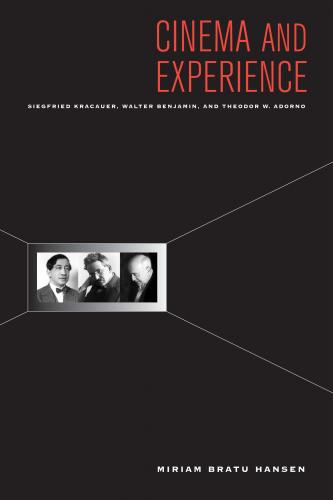Cinema and Experience. Miriam HANSEN
on>
Cinema and Experience
WEIMAR AND NOW: GERMAN CULTURAL CRITICISM
Edward Dimendberg, Martin Jay, and Anton Kaes, General Editors
Cinema and Experience
Siegfried Kracauer, Walter Benjamin, and Theodor W. Adorno
Miriam Bratu Hansen
University of California Press, one of the most distinguished university presses in the United States, enriches lives around the world by advancing scholarship in the humanities, social sciences, and natural sciences. Its activities are supported by the UC Press Foundation and by philanthropic contributions from individuals and institutions. For more information, visit www.ucpress.edu.
University of California Press
Berkeley and Los Angeles, California
University of California Press, Ltd.
London, England
© 2012 by The Regents of the University of California
Library of Congress Cataloging-in-Publication Data
Hansen, Marian Bratu, 1949–2011.
Cinema and experience : Siegfried Kracauer, Walter Benjamin, and Theodor W. Adorno / Miriam Bratu Hansen.
p. cm.—(Weimar and now: German cultural criticism ; 44)
Includes bibliographical references and index.
ISBN 978-0-520-26559-2 (cloth : alk. paper)
ISBN 978-0-520-26560-8 (pbk. : alk. paper)
1. Motion pictures. 2. Kracauer, Siegfried, 1889–1966—Criticism and interpretation. 3. Benjamin, Walter, 1892–1940—Criticism and interpretation. 4. Adorno, Theodor W., 1903–1969—Criticism and interpretation. I. Title.
PN1994.H265 2012
791.4309—dc23 2011017754
Manufactured in the United States of America
20 19 18 17 16 15 14 13 12
10 9 8 7 6 5 4 3 2 1
In keeping with a commitment to support environmentally responsible and sustainable printing practices, UC Press has printed this book on Rolland Enviro100, a 100 percent postconsumer fiber paper that is FSC certified, deinked, processed chlorine-free, and manufactured with renewable biogas energy. It is acid-free and EcoLogo certified.
For Michael GeyerIn memory of Karsten Witte (1944–1995)
CONTENTS
1. Film, Medium of a Disintegrating World
4. Aura: The Appropriation of a Concept
5. Mistaking the Moon for a Ball
8. The Question of Film Aesthetics
PREFACE
The question of how “to engage a living thought that is no longer historically current,” raised by Fredric Jameson with regard to Theodor W. Adorno, has a particular urgency when the body of thought revolves around the cinema, especially in today’s rapidly changing media environment.1 If that ongoing future increasingly became one of the concerns ticking in the background of this study, it also made me more keenly aware of the specific historicity of the writings discussed— less in the sense of their loss of “currency” than in their contemporaneity with key junctures in the history of the cinema and the social and political histories of the twentieth century. Much as they illuminate those junctures, they often do so from an untimely angle, which lends them a different kind of actuality in the present.
At the same time, I couldn’t fail to realize the extent to which this project was bound up with my own history, a history that entailed switching countries, languages, and fields—from Germany to the United States, from German to English, from the study of literary modernism and the avant-garde to the study of film. When I began to read my way into American cinema studies around 1980, the field was dominated by psychoanalytic-semiotic film theory, with its grounding in Lacan and Freud, Althusserian Marxism, and feminism, which had taken Anglophone shape in the British journals Screen and Edinburgh Magazine and the then-Berkeley-based Camera Obscura. This hegemony soon waned, challenged by the competing and asymmetrical paradigms of, on the one hand, cultural studies and, on the other, neoformalism or historical poetics and cognitivism. Yet the intellectual energy that had made psychoanalytic-semiotic theory a magnet for film scholars and a motor in the academic legitimation of cinema studies—at a time when the humanities were under the sway of poststructuralism—seemed to have migrated into the exploration of early cinema, beginning with the legendary Brighton symposium of 1978 and richly fed by the annual Pordenone Giornate del Cinema Muto and other retrospectives. I felt drawn to the study of early cinema, not least because it engaged film history in a theoretically inspired mode that interlaced careful attention to formal and stylistic features with empirical research into conditions of production, distribution, and exhibition as well as broader questions concerning the complex set of transformations commonly referred to as modernity.
I had come from a country in which there was effectively no tradition of film qualifying as the object of academic inquiry (with a few exceptions during the early decades of the twentieth century). There was nothing comparable to the organizational efforts in instruction, archiving, and research in the United States and France, which in recent years have themselves become the object of historical research. To be sure, film history and film theory were part of the curricula of the film academies (Ulm, Munich, Berlin) that had been founded thanks to the film politics
